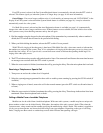If the system is busy, the busy tone sounds and the queue mode is entered automatically when the PTT switch is
released. The busy tone then stops sounding and “IN QUEUE” is displayed. When the system becomes available, either
a dial tone or beep sounds. The dial tone sounds if it is a telephone call, and a beep sounds if it is some other type of
call. The call can then be placed in the normal manner.
If no call is placed soon after this tone sounds, the queue mode is automatically exited and normal operation
resumes. The queue mode is also exited if a call is received on the selected group or if the PTT switch or any of the front
panel switches are activated while no call is being received.
Calls on other system/groups are received normally while in the queue mode. You can respond to the call and then
normal queuing of a call resumes shortly after the call is finished. Group scanning continues if it is programmed on the
system. However, system scanning is temporarily disabled, so calls are not received on other programmed systems.
Auto-Registration
Multi-Net sites can be linked together to provide wide area coverage. Auto-registration may then be used to track
the location of mobiles so that calls can be automatically routed to the correct site. To have this feature, it must have
been programmed by your system operator and system scanning must be enabled by the SCAN switch. In addition, if
the Menu mode “MN AUTOREG” parameter is selectable, auto-registration must be enabled by that feature.
Auto-registration operates as follows: When you move out of range of the current site, the transceiver automati-
cally begins searching for another site. While it is searching, “AUTO REG” and the scan message are alternately
displayed. When a new site is located, “AUTO REG” is no longer displayed and the display changes to the system of
the new site.
The new system that is selected is the first higher system with a different site that could be accessed (wrap-around
occurs after the highest system is accessed). The group that is displayed is determined by transceiver programming. It is
either the same group that was displayed before registration occurred, or the group that was displayed when the new
system was last selected.
Status Messages
Status messages can be automatically transmitted to your dispatcher if that feature has been programmed by your
system operator. A message is transmitted each time the PTT switch is pressed with a Multi-Net system selected.
The STAT option switch or Menu mode “STATUS” parameter (see page 14) are used to momentarily display and
change the current message. In this mode, the Select switch is rotated to display the desired message and then pressed to
select the message. One of up to eight status messages can be selected such as “AT SI TE ”, “LEVNG SITE”, or
“UNLOADING”.
Calls on Priority and Block ID Codes
If your transceiver is programmed with Multi- Net or LTR systems, fixed priority and/or block ID codes may be
programmed in addition to ID codes for the selectable groups. Calls on these ID codes are always received regardless of
which group is selected or Group Scan programming (as long as the system with the codes is selected or scanned).
Calls on fixed priority ID codes and also certain Multi-Net special calls may have a higher priority than a call
being received. If a call with a higher priority is detected, the current call is immediately dropped (if one is being
received) and the transceiver switches to the higher priority call.


















